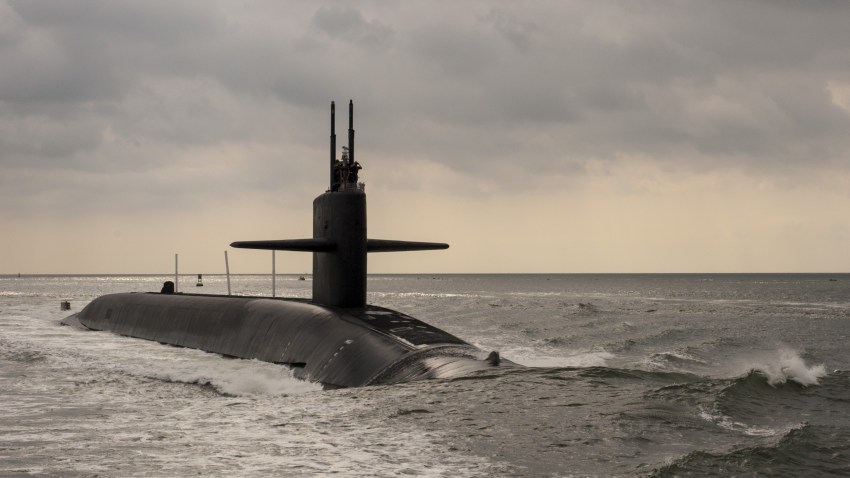The least visible leg of America’s nuclear deterrent, its fleet of stealthy ballistic missile submarines, is widely considered to be its most effective. It is also phenomenally expensive even by the standards of Pentagon acquisition programs.
This is one reason that the Senate Armed Services Committee, in its recent markup of the fiscal year 2015 National Defense Authorization Act (NDAA), moved to establish a “
National Sea-based Deterrence Fund” to ensure that the Navy replaces the current fleet of Ohio-class submarines “at the appropriate level of priority” assigned to it by the Navy leadership.
This is an acknowledgment of the pressures on the Navy budget, and the shipbuilding budget in particular. The total size of the U.S. fleet is on a downward trajectory, and there is a real risk that an expensive, single-mission ship like the next-generation ballistic missile submarine, or SSBN, could squeeze other priorities like attack submarines and aircraft carriers.
During a recent presentation, the Navy’s program manager for the Ohio replacement, Capt. William J. Brougham, said that construction of the first ship would have to begin in 2021 in order for the first patrol to take place in 2031. He anticipated that the first ship of the 12 ships planned
would cost $6 billion to $7 billion to construct, not including design work, with each additional ship hopefully costing as little as $5 billion to $6 billion.
A Congressional Research Service report on the Ohio replacement has projected that spending on the program
will rise from the $1.2 billion requested in fiscal year 2015 to over $3.5 billion in fiscal year 2019. The report cited a Government Accountability Office estimate that the total acquisition cost of the program would ultimately be $95.1 billion in constant 2014 dollars. This does not include the cost of submarine-launched missiles or the nuclear warheads they carry.
Unlike many other U.S. Navy ships, SSBNs perform only one mission. Moreover, the invisible nature of that single mission means that SSBNs don’t contribute to Navy goals like forward presence or crisis response.
Seth Cropsey, a former senior defense official in the Reagan and George H.W. Bush administrations who directs the Center for American Seapower at the Hudson Institute, puts it somewhat more bluntly. Nuclear deterrence “has nothing to do with seapower” itself, he says, beyond the capabilities that submarine-launched missiles offer as a nuclear weapons delivery system.
Given that Navy shipbuilding accounts are “insufficient,” he says it is “understandable and rational” to argue that the costs of designing and building SSBNs should be borne “over and above the Navy’s normal budget.” He predicts, however, that Congress will not be sympathetic to this view.
A retired naval officer and current naval market analyst, who wished to remain anonymous to discuss a politically sensitive matter candidly, says that the Ohio-class replacement will be a fundamental driver of the shape of the U.S. fleet in the coming decades. He observes that the U.S. must either allocate more money for shipbuilding, or end up building fewer ships than planned.
He anticipates that there will eventually be a compromise to preserve the sea-based nuclear deterrent and “maintain the overall fleet structure in its current form.” This could involve extending the life of current Ohio-class SSBNs and reducing the number of next-generation systems.
Regardless of Navy budget woes, SSBNs play a central role in both U.S. nuclear strategy and the politics of the nuclear weapons issues. They are believed to be undetectable, and can quickly deliver large numbers of thermonuclear warheads to targets around the world. With a few SSBNs on patrol, the United States can retaliate against even a massive nuclear first strike on U.S. territory and military assets.
From a political standpoint, the sea-based leg of the nuclear “triad”—which also includes land-based missiles and strategic bombers—is the least controversial. Even strong arms control advocates who think that the U.S. nuclear arsenal is too large believe that a drastically smaller nuclear force should be substantially or entirely based on submarines. They argue, however, that U.S. deterrence goals could be met with fewer than 12 replacement submarines.
It is not a coincidence that when
a Cato Institute report last year argued for switching from a triad to a “monad”—that is, a nuclear deterrent relying on only one delivery system—the system of choice was submarine-launched missiles. The authors of the study argued that submarines are “the least vulnerable leg” and “offer superior hard-target kill capability” to land-based missiles. At the same time, submarines' mobility allows the United States to avoid politically dicey overflights of nations like Russia or China when firing missiles at a third country.
But if the money to pay for the planned SSBNs isn’t there, neither is the political will to acknowledge it. Eventually, the retired naval officer points out, “something has to give.”

